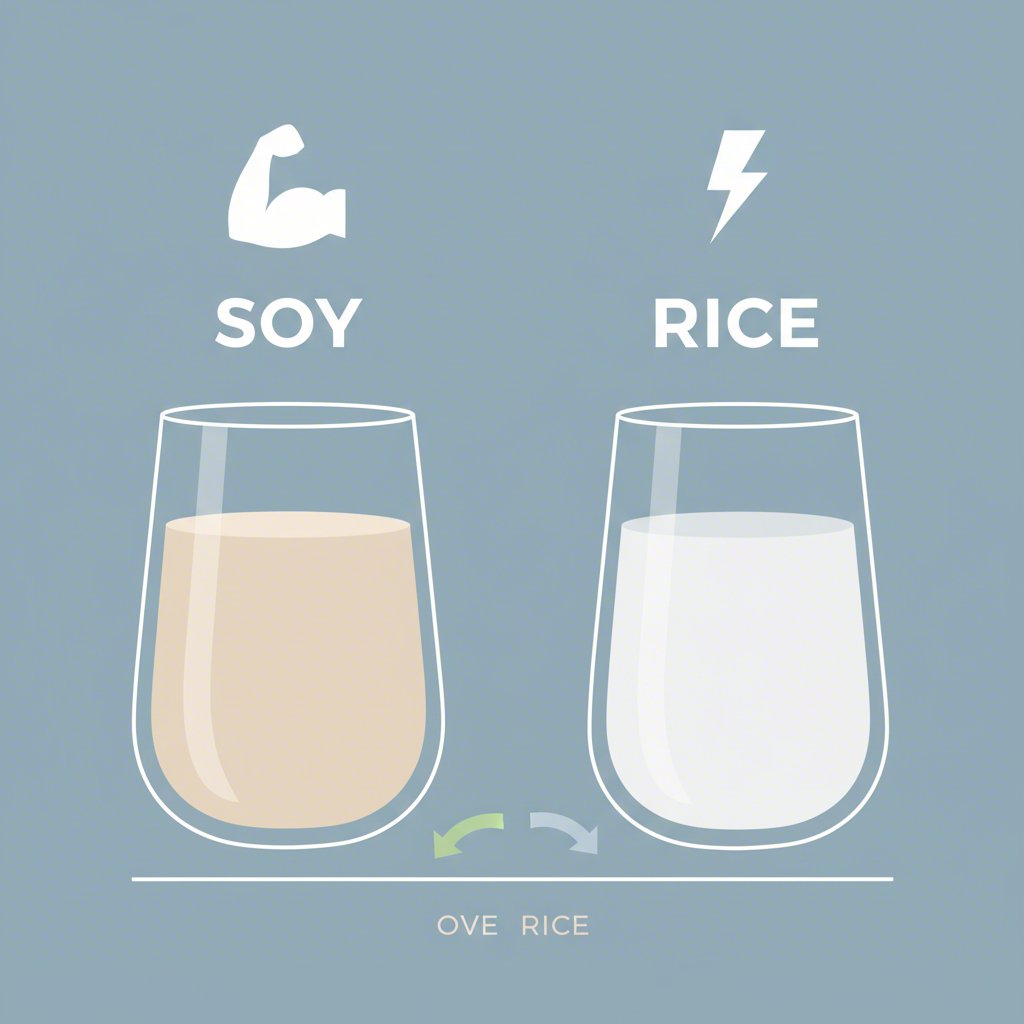TL;DR
When choosing between soy milk vs rice milk, the decision hinges on your nutritional and dietary needs. Soy milk is a nutritional powerhouse, offering high levels of complete protein that make it comparable to dairy milk. It’s ideal for those seeking muscle-building benefits and satiety. In contrast, rice milk is a hypoallergenic option, perfect for individuals with soy, nut, and dairy allergies. However, it’s significantly higher in carbohydrates and naturally occurring sugars while containing almost no protein.
Nutritional Showdown: A Head-to-Head Comparison
Understanding the nutritional differences between soy milk and rice milk is crucial for making an informed choice that aligns with your health goals. These two plant-based beverages occupy very different places on the nutritional spectrum, particularly concerning protein, carbohydrates, and overall calorie content. Both are typically fortified with vitamins and minerals to make them more comparable to dairy milk, but their base ingredients create fundamentally distinct profiles.
Soy milk is renowned for its high protein content, which is a significant advantage over most other plant-based milks. A typical cup of unsweetened soy milk provides around 7 to 8 grams of protein, similar to a serving of dairy milk. This protein is also ‘complete,’ meaning it contains all nine essential amino acids that the human body cannot produce on its own. This makes soy milk an excellent choice for vegans, athletes, or anyone looking to maintain or build muscle mass. It is also relatively low in carbohydrates and contains healthy unsaturated fats.
On the other hand, rice milk’s primary characteristic is its high carbohydrate content, with a single serving containing upwards of 22 grams. These carbohydrates come from the milled rice used to create the milk, which also results in a higher natural sugar content. Conversely, rice milk contains virtually no protein, typically less than 1 gram per serving. This makes it a less ideal choice for satiety or for those managing their blood sugar levels. While it is low in fat, its nutritional value is largely dependent on fortification with nutrients like calcium and Vitamin D.
To provide a clear overview, here is a direct comparison based on an average 8-ounce (240ml) serving of unsweetened, fortified versions:
| Nutrient | Soy Milk | Rice Milk |
|---|---|---|
| Calories | ~80-100 kcal | ~120 kcal |
| Protein | ~7-8 grams | <1 gram |
| Carbohydrates | ~4 grams | ~22 grams |
| Sugars | ~1 gram | ~10-13 grams (naturally occurring) |
| Fat | ~4 grams | ~2.5 grams |
| Calcium (fortified) | ~30% DV | ~20-30% DV |
| Vitamin D (fortified) | ~15-25% DV | ~15-25% DV |
Ultimately, the choice depends on your dietary priorities. If high-quality protein and a balanced macronutrient profile are your goals, soy milk is the clear winner. If you need a low-allergen, dairy-free alternative and are less concerned about protein, rice milk is a viable option, provided you are mindful of its higher carbohydrate and sugar load.
Taste, Texture, and Culinary Uses
Beyond nutrition, the sensory experience and performance in the kitchen are key factors in the soy milk vs rice milk debate. Their distinct flavors and consistencies make them suitable for very different applications. Soy milk generally has a creamier, richer texture and a more pronounced, slightly nutty or ‘beany’ flavor. This profile makes it a robust substitute for dairy milk in many contexts.
Rice milk, in contrast, is known for its thin, watery texture and a mild, naturally sweet taste. Its subtlety can be an advantage when you don’t want the beverage to overpower other ingredients. It’s often preferred for pouring over cereal, drinking on its own, or using in smoothies where other flavors are meant to dominate. However, its lack of protein and fat means it does not perform well in applications requiring structure or creaminess, such as frothing for lattes or creating rich sauces.
For those who value crafting their own plant-based milks to control taste and avoid additives, investing in a specialized appliance can be a great option. If you’re exploring this, Soy Milk Quick offers a comprehensive guide to the best plant milk makers, helping you find a machine to create fresh soy, almond, or oat milk at home. This allows for customization of sweetness and consistency to perfectly suit your culinary needs.
Here’s a breakdown of the best uses for each:
- Best Uses for Soy Milk: Thanks to its creamy texture and high protein content, soy milk is excellent for frothing in coffee and tea, baking, and cooking. It adds richness to creamy soups, sauces, and desserts, and it can be used to make tofu or yogurt. Its distinct flavor pairs well with savory dishes.
- Best Uses for Rice Milk: With its light body and sweet flavor, rice milk is ideal for drinking plain, adding to breakfast cereals, or blending into fruit smoothies. It works well in certain baked goods where a lighter texture is desired but is not a good replacement in recipes that rely on milk for creaminess or structure.

Health Impacts: Allergens, Benefits, and Potential Downsides
When evaluating soy milk and rice milk, it’s essential to look beyond the nutrition label and consider their broader health implications, including potential allergens and other considerations. The most significant distinction lies in their allergenic potential. Soy is one of the most common allergens, making soy milk unsuitable for a segment of the population. For these individuals, rice milk stands out as an excellent alternative. It is widely considered the most hypoallergenic of all milk alternatives, making it a safe choice for people with dairy, soy, and nut allergies.
Soy milk’s health benefits are largely tied to its composition as a whole food. As a complete protein source, it supports muscle health and satiety. Some studies also suggest that soy products may offer heart health benefits, potentially helping to lower cholesterol levels. However, soy contains isoflavones, which are phytoestrogens—plant-based compounds that can mimic estrogen in the body. While research has largely debunked concerns about these compounds having adverse effects in men, individuals with certain thyroid conditions may wish to consult a healthcare provider.
Rice milk, while safe from an allergen perspective, carries a different concern: the potential for inorganic arsenic. Rice plants can absorb arsenic from the soil and water they are grown in. Health authorities like the FDA advise consuming a varied diet and not relying solely on rice-based products, particularly for infants and young children who are more vulnerable. For most adults, moderate consumption of rice milk as part of a balanced diet is unlikely to pose a significant risk, but it is a factor to be aware of.
To summarize the health considerations:
Soy Milk
- Pros: Contains complete protein, may support heart health, good source of potassium.
- Cons: Is a common allergen for many adults and children.
Rice Milk
- Pros: The least allergenic milk alternative, suitable for those with multiple food sensitivities.
- Cons: Very low in protein, high in carbohydrates and sugar, and may contain inorganic arsenic.
Frequently Asked Questions
1. Which milk is better for weight loss, soy milk or rice milk?
Soy milk is generally considered a better option for weight loss. Its high protein content promotes a feeling of fullness, which can help reduce overall calorie intake. Rice milk is higher in calories, carbohydrates, and sugar, and its low protein content makes it less satiating.
2. Can I use rice milk instead of soy milk in recipes?
Yes, you can substitute rice milk for soy milk, but be mindful of the differences in outcome. Because rice milk is thinner and sweeter, it will result in a less creamy and potentially sweeter final product. It is not ideal for recipes that require frothing or thickening, where soy milk’s higher protein content performs much better.
3. Is soy milk safe for people with nut allergies?
Yes, soy milk is a safe alternative for individuals with nut allergies, as soybeans are legumes, not tree nuts. However, it is a common allergen itself, so it should be avoided by anyone with a known soy allergy.
